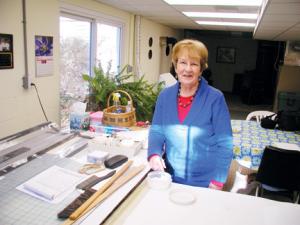Even as computers continue to push the envelope closer to the envisioned paperless society, not a single bit and byte cruncher is anywhere to be seen in paper conservator Janet Koch’s workspace.
“I work on anything that’s a piece of paper – prints, drawings, watercolors, letters, manuscripts, business and institutional archives, maps, posters, newspapers and family heirlooms,” says Koch, (pronounced cook) in her Rehoboth Beach area studio-lab.
Koch became a resident of the Cape Region after retiring a few years ago.
“New Jersey taxes are up there. We had already downsized, and we had two friends who had come down here – one to Lewes and another to Rehoboth. It was very lovely having friends already here,” she said.
Her professional career has been dedicated to, arguably, the most powerful of a triad that also includes rock and scissors.
Koch was born in Massachusetts and grew up in Wellesley Hills. She remained in New England where she attended Brown University, taking an undergraduate degree in art history.
“I was hired in Boston at the Massachusetts Historical Society. They hired me green. It was the infancy of paper conservation,” Koch says.
She attended adult education classes taught by some of the country’s leading paper conservators.
She apprenticed at the Morgan Library and Museum in New York City, where she studied under the institute’s paper conservator and its bookbinder.
“I also used to go to the Boston Museum and pick the guy’s brain. He wasn’t too forthcoming,” she says.
She met and married Charles Koch – her maiden name is Woodley – and the couple moved from Massachusetts to New Jersey.
In New Jersey, she learned the New Jersey Historical Society director was friendly with the paper conservator at the Morgan library and they arranged an apprenticeship for her at the library.
“It was fabulous. I went into New York on the train, and I would take materials that belonged to the New Jersey Historical Society, and they’d teach me how to repair them at the library. That was what got me going,” Koch says.
Since then, Koch has been handling and healing paper for a variety of clients and institutions.
“This is something I’ve been doing all of my life. Mostly with the New Jersey Historical Society, but also, as a consultant, I worked with the University of Medicine and Dentistry of New Jersey in their special collections,” she says.
She has also worked for Princeton University, Seton Hall University, the Matawan Art gallery and several private collectors.
Koch holds a master’s degree in library science from Rutgers, and is also a professional associate member of the American Institute of Conservation.
As a paper conservator the things she can do – has done – with paper blur the line between art and science. Who knew paper could be dry-cleaned?
“Dry-cleaning sounds very fancy, but it isn’t. This is something draftsmen use,” she said producing a small canister shaker bearing the name Scumex.
“It’s granulated erasers. I sprinkle that on the document and then, with clean hands and circular motion, I go over the document and take off surface dirt. If I were to give a document a water bath, I always dry-clean it first,” she says.
Know the acid test many politicians frequently talk about but probably have never passed? Koch is more than familiar with it.
“Often I get documents that are acidic, and I do de-acidification,” she says, explaining how she sprays them with a chemical and then exhausts the substance from the document.
“I also encapsulate,” she said, showing a feature newspaper clipping about what she did when she worked as a consultant in Morristown, N.J.
“This is loose in here; it’s between two pieces of Mylar, which is pH-neutral, then the edges are heat-sealed,” she said, demonstrating how much abuse the newsprint could take as she wrinkled, crinkled and did just about everything other than hard-crease the clipping.
And don’t confuse encapsulating with laminating, a process paper conservators abhor if improperly used.
“Lamination is irreversible. In conservation, everything is reversible,” says Koch.
Her basement studio-laboratory is equipped to handle a variety of paper ailments.
There’s bookbinding equipment – a book press for working on book spines – a heat press, encapsulating machine, large photo darkroom trays for washing documents; file cabinets for storing large materials flat; exhaust apparatus for drying documents and a humidifying container for adding moisture to them.
“Sun bleaching is the least harmful way of bleaching something. It’s not easy. I have to find the right time of day, cover the tray with a piece of glass and have it outside someplace on a table,” she says.
Koch repairs tears in paper using wheat-starch paste and Oriental – also known as Japanese paper – a handmade, long-fibered paper that’s nearly invisible when in place.
She uses a surgical cotton swab to pull fibers out of the Japanese paper covering the tear.
“Say you have a document with tears right across the writing. You can put this fiber down and it’s filled but transparent; you can still read it,” she says.
“If anyone needs help preparing exhibits, I do that, too,” she says, displaying a book cradle she made explaining it’s the only proper way to display an open book without damaging its spine. She also shows a clamshell box she made years ago, an example of the proper way to conserve a book that needs extra TLC.
“I don’t make them anymore; it wouldn’t be cost effective for people to have me do it. But I can recommend someone who does lots of them,” she says.
She said conservationists specialize in a variety of areas such as architectural materials, objects, photographs, textiles and books and paper.
If you find someone who says ‘I can do everything,’ don’t believe them,” Koch warns.
“I have a long list of clients from New Jersey. But since I’ve moved down here I’ve done work for several historical societies, Lewes, Milton and Rehoboth, and quite a few individuals as well,” Koch says.
Much of Koch’s work comes through word of mouth and her reputation. “I don’t have a website. I think I’m going to have to learn how to make one,” she says.
A computer could yet become part of Janet Koch’s world filled with paper.























































